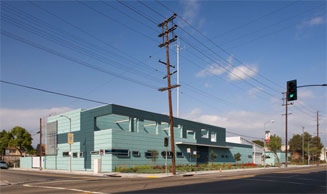
Playa Vista Indian Burial Ground
The state's Native American Heritage Commission is asking developers at Playa Vista to stop excavating land near Centinela Creek, where workers uncovered a 200-year-old Indian cemetery containing the remains of at least 160 people. Playa Vista officials have refused to stop work, saying an agreement with tribal representatives allows the removal of the bodies and provides guidelines on handling of the remains. Workers discovered the burial ground of the Gabrielino-Tongva tribe in October while removing dirt to create a waterway -- Playa Vista calls it a 'stream,' critics call it a 'drainage ditch' -- to catch water runoff from Playa Vista and neighboring housing developments near Marina del Rey. The state commission, responsible for identifying Native American cultural resources, has sent Playa Vista officials six letters since December, asking them to stop removing the remains, which workers continue to find almost every day.
This is only the latest controversy involving the tribe. Last October, a construction crew at Playa Vista found an Indian burial ground; so far.
19 letter, Larry Myers, the board's executive secretary, wrote: 'It is vexing that these activities can continue in what can be interpreted as an ethnocentric disregard of Native American cultural concerns.' Playa Vista officials say that they had expected to find Indian remains, and that excavations were permitted under an agreement crafted by state and local regulators 13 years ago and signed by Playa Vista and three representatives of the Gabrielino-Tongva. The pact included detailed procedures for handling cultural artifacts or bodies found during construction. The agreement was extended in 2001 for 10 years. 'We are doing a comprehensive and respectful job here in accordance with a long-standing agreement with Native American stakeholders,' said Steve Soboroff, president of Playa Vista, the giant residential and commercial complex near Marina del Rey. The agreement was 'signed by Native American parties and they included instructions for dealing with issues exactly like this. Nothing new has come up,' he said.
But the Native American Heritage Commission says the agreement needs revision, given the significant number of remains uncovered. 'We didn't know they would find a cemetery,' said Rob Wood, the board's Southern California program manager.
'Neither the agreement, nor the environmental documents, anticipated such a big find. They should consult with the Native American community and look at alternatives.' Playa Vista officials say the documents still apply, regardless of the number of remains found. 
The state board has no law enforcement powers. It can ask, but not compel, Playa Vista to stop work. It is looking at possible legal action, Wood said.
A commission representative visited the site for the first time March 4. 'We'll keep writing letters, trying to get the developer to stop and look at preservation,' Wood said. Among those opposing the excavation is Robert Dorame, a Bellflower resident who has been designated by the Native American Heritage Commission as the 'most likely descendant' of the Indians buried at the site.